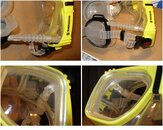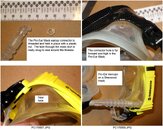rab1412000
Contributor
I just looked at the web site for the "ProEar" mask and I am prepared to describe it as a complete and utter fraud, snakeoil of the highest magnitude.

Here is their claim:How the ProEar 2000 worksPray tell how do you "filter" ambient water pressure from the sea?"
The ear cups cover the ears forming a watertight seal (once properly positioned and taking care to take out all excessive hair). Air is allowed into the ear cups when exhaling through the nose into the mask and then through the thin tubing which runs from the mask skirt into the ear cups passing through non return valves in the tube and into the ear cups. This allows the air space in the ear cups to equalize according to ambient pressure. The mask, ear cups and indeed the entire respiratory system become a closed circuit equalized air pressure system. The ear cups serve as a primary filter of ambient water pressure from the sea and the tubes mimic the Eustachian tubes allowing the diver to easily equalize the pressure in the ear cup before it ever reaches the ear drum.
How do you equalize the pressure in the ear cup before it ever reaches the ear drum? Pressure is constant for a given depth, there is no gradient, you can't intercept it on the way to its destination.All the diver has to do is gently blow air through his nose to keep the ambient pressure (taken from the regulator) into the mask and ear cups. This creates a kind of 'buffering' effect that basically allows the ears to equalize in 2 stages. The first from the sea pressure into the ear cup and the second from the ear cup onto the eardrum.This is some of the worst claptrap that I've ever read. That paragraph is semantically and scientifically empty.
The action of the silicone tube mimics the Eustachian tube but transports air in a much easier less obstructed fashion. The silicone membrane of the ear cup mimics the eardrum but is obviously more flexible and not effected by cold or pollutants.I'll bet that it's "organic" too.
Some divers will still have to pinch their nose shut in order to equalize but the process should definitely be easier. The ear cups can be cleared of any water similar to clearing your mask.There is no reason what-so-ever that the process "should be easier." While the "ear cups" can have any water in them pushed out, that's not at all the same thing as clearing out water that has seeped in under the silicone membrane into the ear canal. So you wind up with a dry cup over an that has been flooded with the cold, polluted, whatever, water that you were trying to keep out. If you need to keep your ears dry ... a helmet is the best way followed by a dry hood.
The ProEar 2000 mask also protects against ear infections, bony calcium deposits in the ear, and cold.There is no clinical support for any of these claims.
The ProEar 2000 also allows for the directionality of sound, thereby allowing the diver (for the first time) to actually sense where sound direction is coming from!This one I love. The direction of a sound is determined by the time lag at each ear that is created by the differential distance from the sound source to each ear. You can not locate sound underwater with any accuracy because sound travels much faster in water than in air and thus the time lag is much shorter. A small pocket of air over each ear will not change this.
My post here in no way reflects the opinion or stance of ScubaBoard or it's management. I relies solely on an understanding of the basic laws of physics, simple anatomical concepts and the January 2001 issue of DAN's Alert Diver.
thats a funky explanation indeed.
but it does work for the reasons i mentioned above.
and with regards to sound, you do tend to hear better underwater, air is a better medium for transmitting sound and im thinking that that small air pocket in the cusps somehow aids in sound propagation. i do not recall being able to sense sound direction however.






